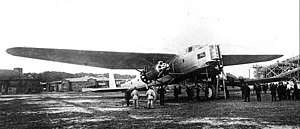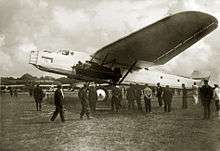Grigorovich TB-5
Grigorovich TB-5 (Russian: Григорович ТБ-5) was an experimental heavy bomber designed and tested in the Soviet Union in the early 1930s. Designed as a competitor for TB-3, TB-5 was intended to be powered by two FED 24-cylinder X engines of 746 kW (1,000 hp) each. When these were canceled, the underwing pods were revised to each house a pair of Bristol Jupiter engines in a push-pull configuration. Despite projected performance inferior to TB-3, it was hoped that TB-5 would gain an advantage by using less metal (in short supply at the time) thanks to its mixed construction of fabric-covered metal frame.[1]
| TB-5 | |
|---|---|
 | |
| Role | Heavy bomber |
| National origin | Soviet Union |
| Designer | Grigorovich |
| First flight | 1 May 1931 |
| Status | Retired |
| Primary user | Soviet Union |
| Number built | One |
Test flights began on 1 May 1931 with disappointing results, in part due to poor thrust of the rear-facing engines.[1] The prototype TB-5 was wrecked in a crash landing following the in-flight detachment of an engine in the spring of 1932,[2] and with the entry into service of the superior TB-3 that year, the TB-5 project was abandoned.[1]
Specifications (TB-5)

Data from Shavrov 1985[1]
General characteristics
- Crew: Six[3]
- Length: 22.1 m (72 ft 6 in)
- Wingspan: 31 m (101 ft 8 in)
- Wing area: 150 m2 (1,600 sq ft)
- Airfoil: root: TsAGI R-II (18%) ; tip: TsAGI R-II (12%)[4]
- Empty weight: 7,483 kg (16,497 lb)
- Gross weight: 12,535 kg (27,635 lb)
- Powerplant: 4 × Bristol Jupiter V 9-cylinder air-cooled radial piston engines, 336 kW (451 hp) each in tandem nacelles
- Propellers: 2-bladed variable-pitch propellers
Performance
- Maximum speed: 180 km/h (110 mph, 97 kn)
- Range: 2,600 km (1,600 mi, 1,400 nmi)
- Wing loading: 84 kg/m2 (17 lb/sq ft)
- Power/mass: 0.107 kW/kg (0.065 hp/lb)
Armament
- Guns: Two turrets, each with 2× 7.62 mm (0.3 in) PV-1 machine guns
- Bombs: Up to 2,500 kg (5,512 lb) of bombs
References
| Wikimedia Commons has media related to Grigorovich TB-5. |
- Shavrov V.B. (1985). Istoriia konstruktskii samoletov v SSSR do 1938 g. (3 izd.) (in Russian). Mashinostroenie. ISBN 5-217-03112-3.
- Gunston 1995, p. 91.
- Gunston 1995, p. 90.
- Lednicer, David. "The Incomplete Guide to Airfoil Usage". m-selig.ae.illinois.edu. Retrieved 16 April 2019.
- Gunston, Bill (1995). The Osprey Encyclopedia of Russian Aircraft 1875–1995. London: Osprey. ISBN 1-85532-405-9.